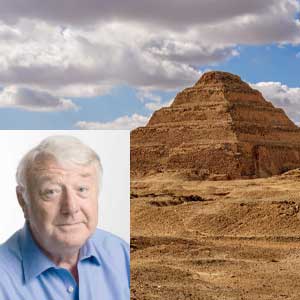At the moment, I’m dealing with a health problem that is occupying most of my time. So apologies for neglecting this “Now & Then” space.
However, I came across the following article when going through my computer files, and thought it might be of interest, and even of amusement.
If all goes well, normal service should resume fairly soon…
THE CLERK FROM THE ACCOUNTS DEPARTMENT
I agree. “The Clerk from the Accounts Department” isn’t what you’d call an inspiring title for a tale. Not designed to whet your appetite. But bear with me, as I think you’ll find it interesting.
In any case, I’m not going to start with the clerk from the accounts department. I’m going to start with Pyramids – which are interesting if you are enthusiastic about old piles of stones. Extremely old piles of extremely old stones.
Take the Great Pyramid of Cheops. The biggest of the trio located at Giza in Egypt. It’s one of the Seven Wonders of the ancient world, and the only one largely intact. Once isolated in the desert landscape, the Pyramids are now a stone’s throw (no pun intended) from the suburbs of Cairo.
People come from all over the world to look at them. And most are disappointed because they are no longer standing in magnificent isolation. And also because the Sphinx isn’t as big as they expected.
(Incidentally, this is a condition shared by Copenhagen’s Little Mermaid. When visitors to the Danish capital go down to the harbour in order to see her, they recoil in disappointment and say: “But, she’s so little”. Yes, folks, the clue is in the name.)
But back to the Great Pyramid. It took about ten or twenty years to build when there wasn’t much technology about, but an ample supply of cheap labour. Those who understand such things reckon it was completed around 2,560 BC. And, though they didn’t know it, those cheap labourers had built the tallest structure on the planet – 481 feet from base to tip, since you ask.
It remained the tallest structure on the planet for well over 38 centuries. Then, one day between AD 1307 and 1311, a gang of workmen erected a lead-lined wooden spire on top of one of the towers of Lincoln Cathedral and surpassed the Great Pyramid by a little over 40 feet.
Like their fellow-builders in ancient Egypt, they wouldn’t have known they were record breakers. Which is something of a pity, I think.
Now that I have diverted you with that tale, I want you to put it into the back of your mind and turn your thoughts, instead, to another ancient structure. The Pyramid of Djoser.
(I realise you weren’t expecting this sharp change of subject, but you’ll have to get used to it, because that’s the way my mind works, and, in any case, I thought the Great Pyramid/Lincoln Cathedral story was too good to pass up.)
Are you with me? Good.
The Pyramid of Djoser (or Zoser) is in the Saqqara necropolis, located to the north west of Memphis, which was the capital when Djoser ruled the Old Kingdom of Egypt. He was the first or second king of the third dynasty, though that’s not especially relevant. He reigned for only 19 years, or possibly 38, according to which expert you heed, which, I think, tells you more about “experts” than it does about Djoser.
But he wasn’t particularly important in the context of either the third dynasty or in what my old history tutor was fond of calling “The Great Scheme of Things”.
So forget about him and concentrate instead on the pyramid that was to be his tomb. Its claim to fame is that it was the first monumental structure to be build of stone (mud bricks were, previously, the usual option) and the first to employ the “step” system – with a large platform having a smaller platform built upon it, and so on until six such platforms stood, imposing, impressive and formidable, as suited the chap who was to occupy the structure.
(Incidentally, those platforms were called “mastabas”, but I only mention this to show you what a smartarse I can be when the mood takes me.)
Now that we have got to Djoser’s Pyramid, I expect you are wondering what the heck this story has got to do with the history of holidays. Here it comes.
When archaeologists were rooting around its ruins, many years ago, they came across graffiti. Really ancient graffiti. Ancient as in 5,000 years or so. And they deciphered this:
“Hadnakhte, scribe of the Treasury, came to make an excursion and to amuse himself on the west of Memphis.”
Nobody knows why he felt impelled to leave that message. But that “scribe of the Treasury” – or “clerk in the accounts department” – provides the first written evidence that people were in the habit of taking holidays. Historians knew the ancient Egyptians took days off to mark religious festivals – 70 a year, they calculate, but as I don’t know how many days made up an ancient Egyptian year, that information is, in a way, irrelevant.
However, the aforesaid experts had no idea, until Hadnakhte came along, that the Egyptians “made excursions” for amusement only.
So Hadnakhte features in a history of holidays because he’s the world’s first recorded holidaymaker. There were probably others before him, but he was the one who took the trouble to leave his mark…..
The sentence I quoted is only part of his message to posterity, by the way. He actually dated it “Regnal year 47, 2nd month of the season of Peret, day 25”, which enables the folk who know about such things to declare that he made his mark in 1,232 B.C – by which time the Pyramid was already 1,500 years old.
He also mentions that he was accompanied by his brother Panakhte, who was a scribe to the Vizier, and that his parents were Sewel and Tauseret. Which is, I think, probably more information than we need.
The downside of Hadnakhte is that he can theoretically be held responsible for the graffiti daubed and carved on tourist sites by those who came after him.
In all my travels, the worst location I encountered in this regard was the temple of Poseidon high above the sea at Cape Sounion.
It’s just 69 kilometres (43 miles) south east of Athens at the southernmost tip of the Attica peninsula, so is nowadays a popular day-trip destination.
In earlier times visitors would have taken much longer to get there from the Greek capital, and would certainly have stayed longer than the few hours allowed by the coach tour companies nowadays. And our Victorian forebears certainly made the most of it, judging by the mass of graffiti they left.
Some of the names must have taken the best part of a day – or more – to inscribe. I sometimes wonder, fancifully, if rich tourists employed professional carvers, in the same way that the Grand Tourists of earlier times had sketch artists in their retinues.
At the temple site today, tour guides will eagerly point to one name (protected by a sheet of clear Perspex when I was there). “Byron”.
I have my doubts about the authenticity of this, suspecting that one of his fans probably carved it to honour his memory. I cannot believe Lord Byron himself would have defaced a monument he clearly held in such regard. As “Don Juan” attests.
“Place me on Sounium’s marbled steep.
“Where nothing, save the waves and I,
“May hear our mutual murmurs sweep.
“There, swan-like, let me sing and die.”
Graffiti on that scale annoys me, as I think it probably annoys you. For one thing it displays unbelievable arrogance on the part of the writer. (I almost wrote “monumental” there before realising the unintended pun.) For arrogance it must be that makes a person believe his or her name will improve the appearance of an ancient building. Though, with the passing of time, the graffiti itself becomes of historic interest.
More years ago than I care to remember, I was taken to the Cenacle on Mount Zion, in Jerusalem. There, a church has been built over the site of King David’s tomb and, on the floor above, is the room in which, it is claimed, the Last Supper was held.
Now as this building dates only from the 12th century, and was constructed by Crusaders, there’s absolutely no way in which this can be true.
However, visitors down the centuries have made their way to that place and, with due solemnity, climbed the stairs to view the room. Leaving their servants, or bodyguards, or whoever, to wait below….
So, bored with waiting, they carved their initials, along with symbols, dates and other graffiti in the stone of the doorway at the foot of the stairs, and on the walls around it. I confess I found those carvings more fascinating than that questionable room above.
However, I leave the last word on the subject of historical graffiti to the French author Gustave Flaubert. In a letter to his uncle in 1850, he complained of “the number of imbeciles’ names written everywhere” in Alexandria.
He added: “…A certain Thompson of Sunderland has inserted his name in letters six feet high on Pompeii’s column and it can be read a quarter of a mile off. There is no way of seeing the column without seeing the name of Thompson. This imbecile has become part of the monument and is perpetuated with it.”












